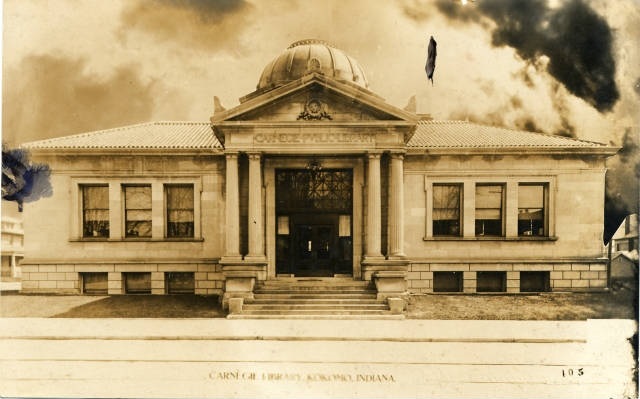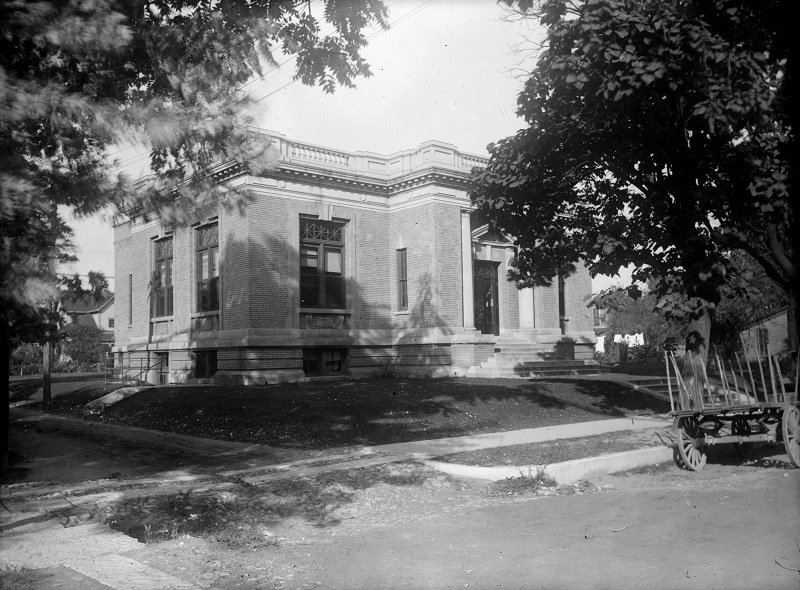
Plan your visit
More than Books: Carnegie Libraries in Indiana
September 13, 2023

It probably comes as no surprise that the librarian authoring this blog loves libraries.
When tasked with designing an exhibit to be on display in the IHS library, I chose to research libraries. I learned that the history of public libraries in Indiana is far more interesting than I anticipated.
Though some public libraries in Indiana existed earlier, between 1901 and 1922, Andrew Carnegie’s library philanthropy funded 164 ‘Carnegie’ Libraries in Indiana, more than any other state in the country. Why? Because Indiana was in the right place at the right time.
Culturally, Hoosiers were ready and receptive to the library movement. The Progressive Era (1890s-1920s) was sweeping the country, Indiana included, and brought with it a period of cultural reform that emphasized a collective responsibility to improve communities for the betterment of society. Additionally, a literary fervor was taking hold in the state. Prominent Indiana authors like James Whitcomb Riley, Gene Stratton-Porter, and Theodore Dreiser (just to name a few) were having their moment in national literary fame. This surge in Indiana author’s popularity sparked an investment in literature for many. These major cultural shifts left communities eager to invest their time and money in libraries.

Carnegie Library, Sullivan, IN, 1911. Indiana Historical Society, P0391, cropped.
Geographically, Indiana was positioned as the natural next step for the development of library infrastructure. States on the east coast, being older than the Hoosier State, had already invested in public libraries. Thus, library systems were established, and private philanthropy was not needed. Given its geographic location, by the time Indiana was culturally ready to invest in libraries, Carnegie was ready to give money to just such a cause.

Carnegie Library, Marion, IN, 1913. Indiana Historical Society, P0408
To be considered for library funding, applicants had to provide proof of a planned building site and a taxation plan for library upkeep. Starting in 1908, Carnegie took a more personal handle on the architectural design of the libraries he was funding. To keep costs appropriate and to avoid architectural errors, Carnegie published a guide to library architecture that provided standards for libraries Grant recipients were expected to consult these guidelines to receive funding.
Of the 164 Carnegie-funded libraries in Indiana, 106 are still being used as public libraries. Some, if not most, have been architecturally modified to make room for bigger collections and modern technology. Of the 58 no longer serving as libraries, 40 are being used in other capacities private, public, and commercial. The remaining 18 were, unfortunately, demolished.

Carnegie Library, Greenfield, IN, circa 1900s. Indiana Historical Society, P0003, cropped.
If it wasn’t for Hoosier dedication and Carnegie funds, the public library system we know, and love may not be what it is today. If you’d like to learn more about libraries in Indiana, please visit the William H. Smith Memorial Library at the Indiana Historical Society to view my case exhibit from now through the end of October 2023.
Source material:
McPherson, Alan. “Temples of Knowledge: Andrew Carnegie’s Gift To Indiana.” Indiana: Hoosier’s Nest Press, 2003.









